All Time Worst Cars For Snow And Ice Driving
According to the data and reviews, the most likely list of these cars is the worst in snow, rain, ice, wind, and fog. Many parts of the country will have to deal with snow sooner or later. Driving in snowy conditions can be dangerous in any vehicle, most of the downlisted pieces are the worst cars for snow in winter driving more reasonably than others.
Sincerely, No car is good in the snow more often, the drivers are further so much of the problem for driving on snow. Which ultimately compels us to maximize the worst cars for snow driving inherently high in number.
Is it reasonable to say that you are one of the unfortunate owners who could be left marooned? YES! NO? Okay, let’s figure it out.
All-Time Worst Cars For Snow
It’s hard to argue, there are many, many horrific contenders for the title of worst car for snow but we will see the approach to the most awful car models experienced driving terribly on snow.
Some cars probably had good feedback when released as a concept but it has not been up to the mark of this winter cliche.
List of 10 worst cars for ice according to data and reviews:
10) Porsche 911 GT3 RS
Plenty of Porsche 911 GT3 RS drivers confined their rides to the garage once the white stuff takes over the road. However, this isn’t always the case.
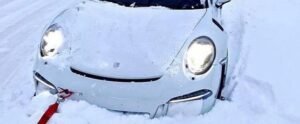
The Porsche 911 is definitely not optimized for driving in snow—super wide high-performance rear tires, the engine in the back, and low to the ground which put the Porsche 911, one of the contenders on the list of worst cars for winter driving.
That said, some owners will put winter snow tires on special rims on their 911 and do pretty well. It’s possible to get a 911 with all-wheel drive, too. AWD, combined with winter tires, makes a 911 fairly serviceable for driving in snow.
Have a look at the demonstrated image of the Porsche 911 GT3 RS playing in the snow.
There are lots of pictures of European owners driving their 911s to the ski slopes with skis strapped on the back or top. So, it can be done. Keep in mind that this car is very low set so it is easier than a regular car to get stuck on deep snow but 10–15cm of the white stuff should be passable with little drama.
9) Most BMW series
While sleek, low-to-the-ground BMWs are incredibly fun to drive on dry roads, they actually become an obstruction in snow. Try driving over a pile of snow in a car with 4 inches of clearance is going to be a lot tougher than one with 8 inches of ground clearance! that includes BMW 1 Series, BMW 3 Series, BMW 5 Series, and BMW 7 Series.
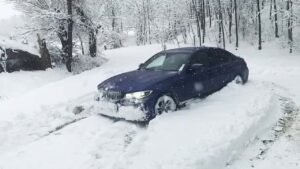
Now while I’m not suggesting that you go put a lift kit on your BMW, this is more of a practical piece of advice. Although, there always remains the alternative. Just give a look down below.
Are BMW’s good in snow? With proper winter tires, BMWs can perform very well in snow. Models with the xDrive all-wheel drive system will handle even better in a variety of wintry conditions. From : https://vehicleanswers.com/are-bmw-good-in-snow/
Related article: Smart Cars In Snow
8) Audi Q7
A common error on frozen roads is getting into an understeer situation and continuing to pile on more steering lock, rather than backing off the throttle, or even carefully applying the brakes.

Yet another cone-swerving activity taught me what that situation feels like, and how to handle it.
Four-wheel drive is useless when it comes to slowing down over two tonnes of Audi fuelled on a heady mix of inertia and denial. Using the car in front as your crumple zone because you’re in a rush to get to Waitrose just isn’t on. See also, BMW X5, Porsche Cayenne, Range Rover Sport, etc…
7) Lotus Exige 260 Cup
Lotus claims to have integrated some of the latest design philosophies from its high-performance stablemates which include the Exige Cup 380, the Evora GT430, and the track and competition-only Elise Race 250.

This is another rear-wheel drive with semi-slick tires. Much better for taking out on a nice sunny day!
6) Nissan 200SX
Funny how this S14 turns out to have the looks of an S14a when covered in snow! The headlights are now less round and appear to be sloping up a bit!
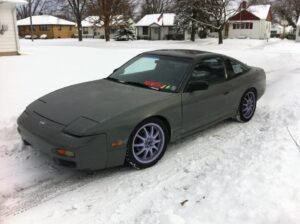
This car needs many repairs from day 1 ! the interior is just standard, but hope to get leather soon!!! the exterior of this car is BEAUTIFUL, might have 2 or 3 dints on it, but on the move, this car is one of a kind that catches your eye! get around 400-500 km from a tank, maintenance is a pain, but once you replace it, it doesn’t happen again!!
This potty, turbocharged rear-wheel-drive coupe from the mid-1990s may be a ‘snow’ drifter’s dream, but it’ll certainly hit the skids in snow drifts.
5) Rolls Royce Phantom
Really, no massively powerful, rear-wheel-drive sedan is the best choice when it comes to tackling a snowstorm, regardless of how advanced its traction control is or whether it’s equipped with winter tires.
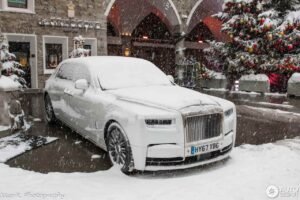
Weighing in at a huge 2,560 kg, this car might sink in very soft snow. We don’t think it would handle very well on ice either, so if you left your house in it on a snowy day, we don’t know where you’d end up!
4) Jaguar F-Type
Particular F-Type is $126,000. Included a set of $12,000 carbon-ceramic brakes. Given that, driving a jaguar f-type car in the winter, it never got the brakes anywhere close to proving their worth so it’s very hard to say if they are worth the price of a new Nissan Versa.
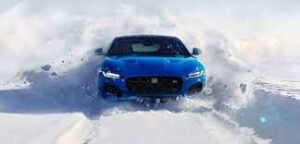
The snow/ice/wet traction mode helps quite a bit. But appropriate tires are always going to be the biggest safety factor in these types of conditions.
3) Chevrolet Corvette
The Corvette can only drive in moderate snowfall. Unless you deliberately want to know how it feels to get stuck in the snow with a sports car, never drive in heavy snow. Keep your car in the garage and use a truck or SUV, if you have one, or just stay at home.
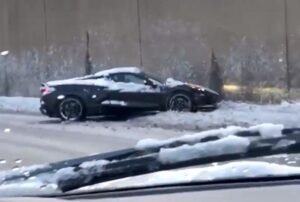
If you must drive your Corvette in snow, do so only if the snowfall is mild and isn’t higher than your car’s ground clearance. Failure to do this and your expensive supercar may be stuck in snow.
2) Ferrari 250 GTO
Since Ferrari’s trademark was technically for toys and model cars and it hasn’t built a full-size vehicle under the nameplate since 1964, it’s unfortunately lost this battle, apparently.
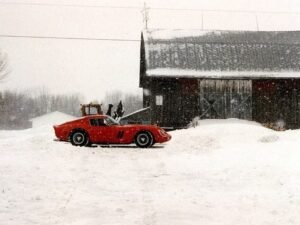
Older Ferraris don’t look that different from the newer ones and the biggest difference is the engine and transmission. Otherwise, it’s mostly similar cars. Thus, there’s doubt most people who rent/drive could even tell the difference.
It’s tempting to compare the GTO Engineering 250 SWB Revival to Singer’s famous 911s.
1) Shelby Cobra
Good tires and weight in the trunk helped some, but not much. Most of it has to do with driver skills. I’d always laugh at the 4x4s in the ditch while Mustang slid on by without a problem.

That said, I don’t think even you’d risk driving a brand-new blown Cobra in the snow. That is just asking for trouble. Just don’t think that 400 ft/lbs of torque and snow are going to get along very well – even with snow tires.
Other Terrible Examples
Cars with engines in front and drive wheels in the back, and little weight on the back. Lots of power and very wide summer tires make the car even more insane. How do you define the worst cars in snow and ice? The cars without stability control or traction control would do even worse.
- Any RWD pickup truck with a V8 engine up front, without snow tires.
- Chevrolet Camaro
- Mazda RX-8
- Any pre-stability control BMW.
- Any RWD Volvo, eg, 740 Turbo, 760 Turbo.
- Any RWD Mercedes without a couple of sandbags in the trunk.
- Any old Detroit barge without snow tires, eg, Lincoln Town Car.
- Any RWD Chevy Tahoe or similar SUV without snow tires.
Tips For Driving On Icy Roads
Driving in snow for the first time can be extremely treacherous, so we advise you to question whether the journey is really worth the financial and emotional cost of a potential accident.

Be aware of your vehicle’s capabilities in winter. Finally, if the weather is looking really bad, ask yourself – is your journey really necessary? If you absolutely have to head out, find the best way to drive in the snow and begin traveling taking a shovel with you.
Keep your distance from other vehicles – especially gritters and snow plows – and don’t change lanes unnecessarily. Remember also that when it’s raining, even if the air temperature rises the road surface will remain very cold – and the rain can turn to ice.
1. Is 4-Wheel Drive Good For Snow?
Both AWD and 4wd is THE BEST choice over others, they’re very capable cars in snow and ice, but it’s still important to pay attention to tire type and tread, as the wrong tires can take away much of the benefit of AWD and 4WD systems. Is AWD or 4wd better in the snow?
Different from the all-wheel-drive model, most four-wheel-drive (mostly introduced as 4WD or 4X4) frameworks are “low maintenance”, requiring the driver to fix them. 4WD frameworks send capacity to each of the four wheels similarly, paying little interference to their traction. Hence, snow road conditions demand 4×4 in snow for better driving on ice roads.
They’re frequently found on pickup trucks and enormous SUVs intended for broad rough ground driving. Four-wheel drive cars function admirably and drive well in snow, especially for individuals who live in rural regions and experience unplowed streets, profound snow, and irregular landscape.
Can 4wd drive in snow and ice? High ground clearance, better traction control in snow, and low-range power delivery to all wheels provided by 4WD pickups or large SUVs can be crucial to winter driving safety. . Hence, 4WD vehicles are not possible options, in any case, to be on the list of worst cars in snow and ice.
2. Is Front-Wheel Drive Good In Snow?
It can be a BETTER choice for driving in snow with front-wheel drive. Most of the car’s weight is above the two driving wheels which aids in traction resulting in better control. FWD vehicles perform better than RWD in the snow. FWD in the snow is pretty safer, but it’s still important to have the right tires on the car, such as bald tires, or summer tires.
Most passengers and crossovers are designed with a front-wheel-drive (FWD) car system that leads driving in the snow difficult and quite dangerous.
When coupled with a set of good winter tires, for winter driving safety these vehicles can perform even better on snow and ice. . Front-wheel drive vehicles work sufficiently well because of which this category also doesn’t fit the label”worst cars in snow and ice”.
3. Is Rear Wheel Drive Good In Snow?
Rear-wheel drive (RWD) is the WORST choice to go around the white stuff considering the winter driving safety. Which eventually push rear-wheel-drive vehicles to fall into the top nominated category to be on “the worst cars in snow and ice list”. What RWD means is when you press the gas pedal on your car, your rear wheels are the ones that will spin and propel your vehicle forward.
Rear-wheel drive in winter is often less ideal for driving in the snow. And have a tendency to slide in the snow and requires very careful driving. RWD cars typically have ‘summer’ sports tires which are very unsafe for driving through snow. So, how to drive RWD in the snow?
If so you have an RWD car and expect to have to drive through the snow, make sure to put snow tires on your car. A good set of winter tires can be a tremendous help to give these vehicles secure traction, handling, and driving in snowy and icy conditions.
How bad is RWD in the snow? Rear wheel drive cars are a bad choice and also are the most dangerous worst cars in snow and ice.
4. Is Snow Bad For Your Car?
When heavy snow and slush slide forward down the windshield during braking, it can mangle wiper blades, and arms and damage the linkage and motor. The same can happen to the rear wiper.
Another area to consider is the vehicle HVAC system.
When loose snow isn’t cleared off before starting the vehicle and turning on the heater, this snow can be drawn into the system, where it can waterlog a cabin air filter or cause problems with heater control doors and linkages.
5. Which Car Is Best In The Snow?
Sincerely, No car is good in the snow, but the drivers are so much of the problem, most can’t drive safely in summer conditions and drive twice as badly in winter ice, snow, and sleet, conditions.
Any car, equipped with decent winter tires, will handle snow well whether the cars are rear-drive, front-drive, manual select 4×4, or AWD. All handle snow issues pretty satisfyingly.
A good contender would be a 4-wheel-drive pickup with nothing in the bed.
4WD vehicles are the most effective in snowy conditions and provide the highest levels of safety and control but are often more expensive than an FWD cars. And while they’re very capable in snowy conditions, it’s still important to pay attention to tire type and tread, as the wrong tires can take away much of the benefit of 4WD. The number of worst cars for snow is comparatively less on the 4WD system.
6. Do Winter Vehicles Need Snow Tires?
While many people think that all-wheel drive is enough to take on dangerous ice and snow, there is almost no difference between AWD-equipped vehicles and common front-wheel-drive cars when it comes to cornering, braking, and handling in winter weather. Snow tires for cars are the most important factor for controlled traction on winter roads.
However, there is a 25-50% traction difference between all-season and winter tires. While AWD has its advantages, the use of the best winter tires makes the single biggest difference when it comes to braking and steering on snow and ice.
You can simply make a difference by adding cheap winter tyres for an adventurous and safe ride in the snow.
7. Why Snow Tires Are Important?
Almost all winter car tires have a very soft rubber compound that stays flexible even as temperatures drop, and this provides more controlled handling. improve the grip by avoiding hydroplaning and enhance traction on snow & ice by providing the channels that drain water as well as expel snow.
As multiple independent tests have concluded, winter car tires are the greatest differentiating factor in a vehicle’s performance on snow and ice and only make an AWD or 4WD vehicle even more capable in winter weather.
It is alarming to note the immediate loss of traction at slow cornering speed; the all-season tire simply will give up without much effort.
Related article: Are Smart Cars Safe To Drive In Snow?

